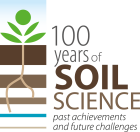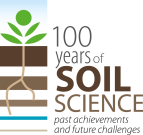Soil health in achieving the Sustainable Development Goals
Soil health is defined as “the ability to sustain productivity, diversity and environmental services of terrestrial ecosystems”, extending the significance of soil health far beyond the historically concepts of soil fertility and soil quality, including human health and sustainability goals for planetary health.
Thus, it will significantly contribute to reaching the targets of the following Sustainable Development Goals (SDGs): SDG 2 (zero hunger); SDG 3 (Health); SDG 6 (clean water and sanitisation); SDG 12 (sustainable consumption and production); SDG 13 (climate action) and SDG 15 (life on land).
However, several issues have to be addressed to achieve such goals. For example: Defining soil health indicators, Dynamics and functional role of soil biodiversity, Harmonizing soil monitoring strategies, Soil pedodiversity and biodiversity, Soil legacy effects…
Soil governance
Soil is a non-renewable resource. Its use requires policies, strategies, and processes of decision-making at the local, national and supra-national level.
Governing the soil requires international and national collaboration between governments, local authorities, industries, research institutions and citizens to ensure implementation of coherent policies that encourage practices and methodologies that regulate the soil’s use to avoid conflict between users to promote and ensure soil security and sustainable land management. Coherent soil governance is the foundation for promoting sustainable agriculture and ensuring food security in addition to all essential ecosystem services.
Under this theme, different sessions could address issues like: Soil Security, Soil Policies, Soil Economy, Soil ecosystem Services, Soil and Education, Soil Awareness, Soils and Societal Development, Sustainable Soil Management, Sustainable Agriculture, Participatory processes in Soil Conservation, Soil Role in Food and Water Security, Soils as Cultural Heritage, Soils and Landscape Management, Soil Partnerships, Living Labs and Lighthouses…
Soil in the circular economy
Circular economy is an economic system focused on maximizing the reuse of natural resources and products, minimizing their depreciation. We consider the soil a natural resource as the water.
As the formation of topsoil and the recovery of land and soil quality are extremely slow processes, they are considered as non-renewable resources. Therefore, the recovery and reuse of land and soil is necessary to secure future provision of natural resources and services for the growing world population.
Soil plays an important role in the circular economy as, for instance, the provider of space for societal activities to take place. It stores the stock of mineral resources and offers possibilities for producing biobased resources to replace the use of mineral resources.
Soil’s role in the biogeochemical cycles is very important for closing the cycles of water and nutrients. The use of natural cycles as ecosystem services is efficient in reducing the implementation of resource-intense technical practices.
Soil sciences impact on basic knowledge
Soil consists of a three-phases system containing solids, liquids and gases that strongly interact with each other in the pedogenic processes. Mineral fragments, organic matter, and soil air evolve through a series of biological activities, chemical reactions, and physical forces that are influenced by different environmental factors. Soil health refers to the capacity of soil to sustain or improve productivity, plant health, and higher trophic levels, as well as air and water quality in natural and managed ecosystems. Interdisciplinary knowledge of chemistry, physics, atmospheric science, soil science, biology, natural history, and ecology is needed to recognize the role of soil in regulating greenhouse gases, reducing nutrient export from agricultural land, controlling pests, and supporting biodiversity that provides many ecosystem services to society.
Soil in the digital era
Soil information technology supports many research fields including pedology, landscape modeling, natural resources management, land evaluation, land use planning, carbon storage, land use/land cover change, environmental risk assessment and modeling and smart/precision farming.
There is increasing demand for soil information as it relates to: location, quality and quantity of soil properties, processes and interactions with various natural resources.
Under this theme, different sessions could address issues like: Digital Soil Mapping, Pedometrics, Geostatistics, Soil Spatial Variability, Soil Information Systems, Soil Spatial Infrastructures, Decision Support Systems, Soil Modeling, Environmental Modeling and risk assessment, Soil Proximal Sensing, Soil Remote Sensing, Soil Management in Smart Farming, Mapping and Modeling of Soil Ecosystem Services, Mapping and Modeling of Soil Threats, Soil use and climate change modelling…
Soil and humanity
Soils underpin, directly or indirectly, most of the ecosystem services defined as the benefits humanity obtains from ecosystems. Soil scientists have the responsibility to make clear to civil society, policy makers, scientists and experts in other disciplines the overwhelming importance of soil in their lives.
This implies the need for integrating soil sciences in education at all levels and for increasing soil awareness of general public. A well informed society will have the possibility to exploit the numerous functions soil provides while sustaining the continuous provision of ecosystem services.
Under this theme, different sessions could address issues like: soil and humanistic disciplines – history, philosophy, sociology, art, religion; soil and human health, soil and sustainable and liveable cities, soil security and land grabbing, soil education and promotion, soil and human rights…
Equity, diversity, and inclusivity in soil sciences
Globally, women play a substantial role in agriculture and strong linkages between sustainable soil management (SSM) and gender equality have been demonstrated. However, a number of cultural and social constraints exist which hinder a full recognition of women’s role in SSM. An insufficient soil education is one of them. Besides, local soil knowledge, often women driven, is nowadays considered a tool for a sustainable soil management. Despite some encouraging signals, women are still underrepresented in soil science, and in particular in leadership positions and in awards rates.
Supporting equity, diversity and inclusivity in soil science is a key issue for addressing fundamental scientific questions and societally relevant environmental challenges.
Under this theme, different sessions could address issues like: Women in soil science, Underrepresented minorities in soil sciences and soil-related scientific societies, Local knowledge and SSM, Soil education tailored on women and on local/indigenous communities, Ethnopedology…


